必修一英语unit5 reading教案
人教版高中英语必修一 教案: unit 5 Nelson Mandela--a modern hero Reading
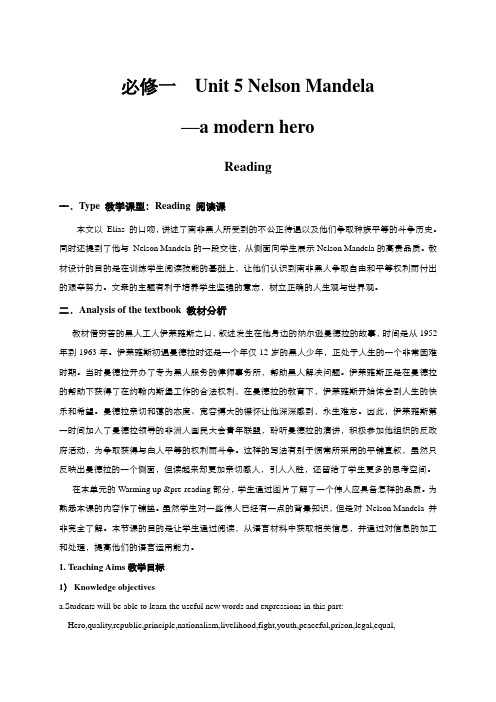
必修一Unit 5 Nelson Mandela—a modern heroReading一.Type 教学课型:Reading 阅读课本文以Elias 的口吻,讲述了南非黑人所受到的不公正待遇以及他们争取种族平等的斗争历史。
同时还提到了他与Nelson Mandela的一段交往,从侧面向学生展示Nelson Mandela的高贵品质。
教材设计的目的是在训练学生阅读技能的基础上,让他们认识到南非黑人争取自由和平等权利而付出的艰辛努力。
文章的主题有利于培养学生坚强的意志,树立正确的人生观与世界观。
二.Analysis of the textbook 教材分析教材借穷苦的黑人工人伊莱雅斯之口,叙述发生在他身边的纳尔逊曼德拉的故事,时间是从1952年到1963年。
伊莱雅斯初遇曼德拉时还是一个年仅12岁的黑人少年,正处于人生的一个非常困难时期。
当时曼德拉开办了专为黑人服务的侓师事务所,帮助黑人解决问题。
伊莱雅斯正是在曼德拉的帮助下获得了在约翰内斯堡工作的合法权利,在曼德拉的教育下,伊莱雅斯开始体会到人生的快乐和希望。
曼德拉亲切和蔼的态度、宽容博大的襟怀让他深深感到,永生难忘。
因此,伊莱雅斯第一时间加入了曼德拉领导的非洲人国民大会青年联盟,聆听曼德拉的演讲,积极参加他组织的反政府活动,为争取获得与白人平等的权利而斗争。
这样的写法有别于惯常所采用的平铺直叙,虽然只反映出曼德拉的一个侧面,但读起来却更加亲切感人,引人入胜,还留给了学生更多的思考空间。
在本单元的Warming up &pre-reading部分,学生通过图片了解了一个伟人应具备怎样的品质。
为熟悉本课的内容作了铺垫。
虽然学生对一些伟人已经有一点的背景知识,但是对Nelson Mandela 并非完全了解。
本节课的目的是让学生通过阅读,从语言材料中获取相关信息,并通过对信息的加工和处理,提高他们的语言运用能力。
1. Teaching Aims教学目标1)Knowledge objectivesa.Students will be able to learn the useful new words and expressions in this part:Hero,quality,republic,principle,nationalism,livelihood,fight,youth,peaceful,prison,legal,equal,law,advise,continue,gold,passbook,ANC,league,stage,vote,position,accept,violence,devote,vote, guidance, blow up, in troubleb. Enable the students to read Elias’ storyc. Guide the students to know the qualities of Nelson Mandela as a great leader2) Ability objectivesa.Develop the students ’reading skills, such as fast reading ,careful reading and summarizingb.Improve the students’ comprehension ability3) Emotion objectivesa,Understand the qualities great person have in common and learn the fine qualities from themb.Develop the students’ moral quality2.Teaching important points教学重点a.Enable the students to read Elias’ story and Learn to grasp the main idea of the text.b.Enable students to talk about the fine qualities of great people,especially Nelson Mandelac.Improve the students’ reading ability3.Teaching difficult points 教学难点a.How to grasp the main idea of the text.b.How to help develop students’ reading abilityc.How to help students learn from Nelson Mandela4.Teaching methods 教学方法a.Student-centeredb.Task-based teaching method(任务型教学)c.Discussion5.Learning methods 学习方法Individual or pair work and group work6.Teaching Aids 教具准备The multimedia三.教学设计1. 总体思路本堂课的主要内容分为四大部分,Pre-reading(阅读前活动) ,while –reading(阅读中活动),post-reading(阅读后活动)以及discussion(讨论) and role play 。
外研版高中英语选择性必修一Unit 5 reading 教学设计
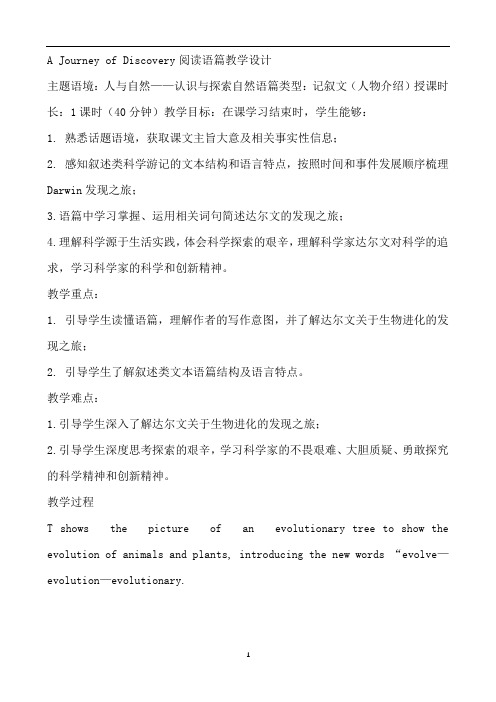
A Journey of Discovery阅读语篇教学设计主题语境:人与自然——认识与探索自然语篇类型:记叙文(人物介绍)授课时长:1课时(40分钟)教学目标:在课学习结束时,学生能够:1. 熟悉话题语境,获取课文主旨大意及相关事实性信息;2. 感知叙述类科学游记的文本结构和语言特点,按照时间和事件发展顺序梳理Darwin发现之旅;3.语篇中学习掌握、运用相关词句简述达尔文的发现之旅;4.理解科学源于生活实践,体会科学探索的艰辛,理解科学家达尔文对科学的追求,学习科学家的科学和创新精神。
教学重点:1. 引导学生读懂语篇,理解作者的写作意图,并了解达尔文关于生物进化的发现之旅;2. 引导学生了解叙述类文本语篇结构及语言特点。
教学难点:1.引导学生深入了解达尔文关于生物进化的发现之旅;2.引导学生深度思考探索的艰辛,学习科学家的不畏艰难、大胆质疑、勇敢探究的科学精神和创新精神。
教学过程T shows the picture of an evolutionary tree to show the evolution of animals and plants, introducing the new words “evolve—evolution—evolutionary.T shows another picture---Darwin with a monkey body. Guess who he is and why? ask the students what they have known about Darwin.T: What have you known about the book?(Arouse students’ curiosity to know more about the book .)T shows the two different forms of “On the origin of species”, to stress the fastest way to find information about a book教学意图:创设情境,利用图片导入主题,引入新单evolve—evolution, ancestor 的学习,激活学生原有背景知识,为下文介绍达尔文的信息进行铺垫;激发学生好奇心。
Unit5ReadingandThinking教学设计-高中英语人教版
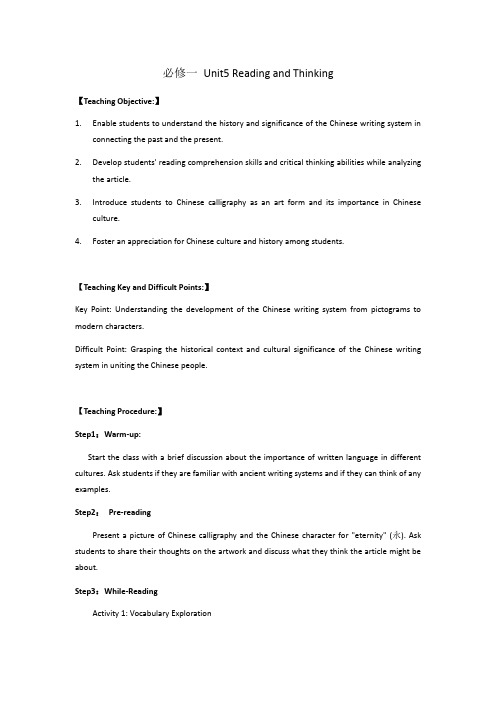
必修一Unit5 Reading and Thinking【Teaching Objective:】1.Enable students to understand the history and significance of the Chinese writing system inconnecting the past and the present.2.Develop students' reading comprehension skills and critical thinking abilities while analyzingthe article.3.Introduce students to Chinese calligraphy as an art form and its importance in Chineseculture.4.Foster an appreciation for Chinese culture and history among students.【Teaching Key and Difficult Points:】Key Point: Understanding the development of the Chinese writing system from pictograms to modern characters.Difficult Point: Grasping the historical context and cultural significance of the Chinese writing system in uniting the Chinese people.【Teaching Procedure:】Step1:Warm-up:Start the class with a brief discussion about the importance of written language in different cultures. Ask students if they are familiar with ancient writing systems and if they can think of any examples.Step2:Pre-readingPresent a picture of Chinese calligraphy and the Chinese character for "eternity" (永). Ask students to share their thoughts on the artwork and discuss what they think the article might be about.Step3:While-ReadingActivity 1: Vocabulary ExplorationProvide a list of key vocabulary from the article and have students look up their meanings. Ask students to use the vocabulary in sentences to demonstrate their understanding.Activity 2: Reading and ComprehensionDivide the class into small groups and assign sections of the article to each group.Instruct each group to read their assigned section and identify the main points and supporting details. Have each group present their findings to the class, fostering discussion and addressing any questions.Activity 3: Timeline of the Chinese Writing SystemCreate a timeline on the board that shows the development of the Chinese writing system from pictograms to modern characters. Have students place important milestones on the timeline, such as the use of longgu, the Shang Dynasty, and the Qin Dynasty. Discuss the significance of each milestone in shaping the Chinese writing system.Activity 4: Chinese Calligraphy DemonstrationShow students a video or images of Chinese calligraphy being created. Explain the significance of calligraphy as an art form in Chinese culture and its connection to the writing system. Provide students with calligraphy brushes and paper and let them try writing simple Chinese characters themselves.Step4: Post-ReadingReflection and DiscussionLead a class discussion about the article's main points and the students' thoughts on the Chinese writing system. Encourage students to share their reflections on how the Chinese writing system has played a role in connecting the past and the present. Discuss the significance of language in preserving and passing on cultural heritage.Homework:Assign each student a Chinese character and ask them to research its origin, meaning, and historical context. Students should create a presentation or poster showcasing their findings, and they can also demonstrate their calligraphy skills by writing the character beautifully.。
【教案】人教版选择性必修一 Unit 5 reading教案
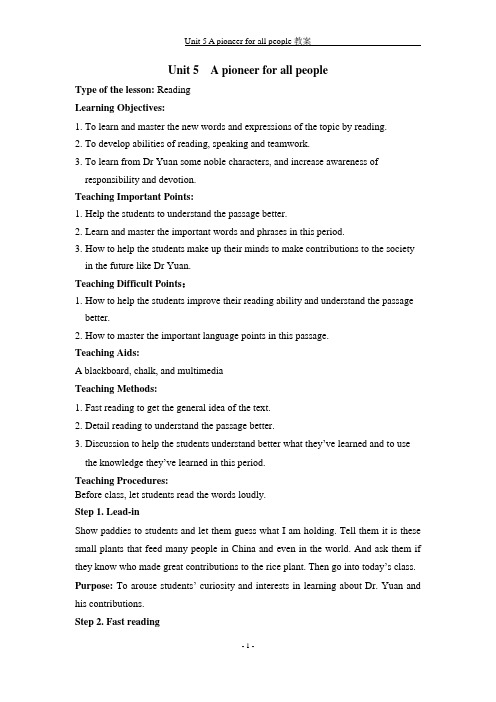
Unit 5 A pioneer for all peopleType of the lesson: ReadingLearning Objectives:1. To learn and master the new words and expressions of the topic by reading.2. To develop abilities of reading, speaking and teamwork.3. To learn from Dr Yuan some noble characters, and increase awareness of responsibility and devotion.Teaching Important Points:1.Help the students to understand the passage better.2.Learn and master the important words and phrases in this period.3.How to help the students make up their minds to make contributions to the society in the future like Dr Yuan.Teaching Difficult Points:1.How to help the students improve their reading ability and understand the passage better.2.How to master the important language points in this passage.Teaching Aids:A blackboard, chalk, and multimediaTeaching Methods:1.Fast reading to get the general idea of the text.2.Detail reading to understand the passage better.3.Discussion to help the students understand better what they’ve learned and to use the knowledge they’ve learned in this period.Teaching Procedures:Before class, let students read the words loudly.Step 1. Lead-inShow paddies to students and let them guess what I am holding. Tell them it is these small plants that feed many people in China and even in the world. And ask them if they know who made great contributions to the rice plant. Then go into today’s class. Purpose: To arouse students’ curiosity and interests in learning about Dr. Yuan and his contributions.Step 2. Fast reading1.Read the title and the first sentence of each paragraph. What kind of text is it?A. A short storyB. A play reviewC. A commercial advertisementD. A biography2. Match each paragraph with its main idea.Para.1 A.Yuan conducted research and developed hybrid rice.Para.2 B.Yuan is old but still full of dreams that he is turning into reality. Para.3 C.Yuan considers himself a farmer.Para.4 D.Yuan decided to study agriculture.Para.5 E.Yuan’s innovation has helped to feed more people.Para.6 F.Yuan cares little for celebrity or money.Purpose: Develop students’ skimming skills by paying attention to the title and the first or last sentence in each paragraph. Let the students know the structure, main idea and writing style of the text.Step 3. Careful readinga.Read paras.1-2 and answer two questions.※The catcher of the paddy fields稻田守望者1.Why does he consider himself a farmer?__________________________________________________________________ Actually, he is one of China’s ______________and known as ________________.2.Why did Yuan Longping choose to study agriculture?A.Because his parents wanted him to do so.B.Because he wanted to win awards in this field.C.Because farmers sometimes suffered from serious shortage of food at that time.D.Because he wanted to make more money by selling seeds.b.Read paras. 3-4※The jumper in scientific research科研跳高运动员Read para.3 and answer two questions.Research : why?Farmers needed to__________in the fields they had to solve the shortage of food.What’s characteristic of hybrids?They usually attain_____________ than conventional crops.Read para.4 and find out Dr. Yuan’s great contributions.Contributions:1)about ___________of domestic rice consumption in China is comprised of crops generated from Yuan's hybrid strains2)Yuan's innovation has helped feed not just China, but many other countries, such as __________________.c.Listen to para. 5 and choose the best answer.1. Did Mr.Yuan retire to a life of leisure?________________________________2.Does he care for celebrity or money?______________________________3.He makes large donations to_________________________d. Read Para. 6 and answer two questions.1.Yuan Longping envisioned rice plants as tall as ___________, with each _______ of rice as big as a broom, and each grain of rice as huge as a __________.2.What was his latest vision of rice? Has it become a reality?_____________________________________________________________________ Purpose: Let the students find some useful information, and get familiar with the text to develop their reading abilities to acquire and deal with information.Step 4. Post reading1.SummaryAfter reading the passage,please fill in the following blanks.Yuan Longping, who 1. __________ (know) as the “father of hybrid rice”, considers himself a farmer. When he was young, 2. __________ concerned him most was farmers’ 3. __________(short) of food to eat, so he chose to study agriculture at college. After graduating in 1953, he worked as a researcher and devoted himself to 4.__________ (create) a kind of hybrid rice, which could attain a 5. __________ (high) yield. In 1974, he succeeded in making it 6. __________ reality. Today, 60% of domestic consumption in China is comprised of crops 7. __________ (generate) from his hybrid strains, for which he has received numerous awards both in China andabroad. But the humorous old “farmer”, caring little 8.______ celebrity or money, isstill living a simple life. Despite his 9.__________ (advance) years, he is trying 10.________(fulfill) his dreams of riding the world of hunger.Step 5 Group WorkAfter the Award Ceremony , Mr. Yuan Longping will be interviewed by a group of journalists. Please elect one student to act as Mr. Yuan and the rest of will be journalists.Preparations:Make a list of questions that you will ask Mr. Yuan._____________________________________________________________________ _____________________________________________________________________ _____________________________________________________________________ _____________________________________________________________________ _____________________________________________________________________ _____________________________________________________________________ _____________________________________________________________________ _____________________________________________Presentation:Step 6 Assignment (Homework)Collect information about hybrid products and you are expected to present it to your classmates in the next class.Purpose: By giving students a situation to use English to build up their correct attitude towards Dr. Yuan’s spirits of responsibility and devotion and develop their ability to cooperate with others efficiently.。
2019新人教高中英语必修一Unit5Reading and Thinking教案
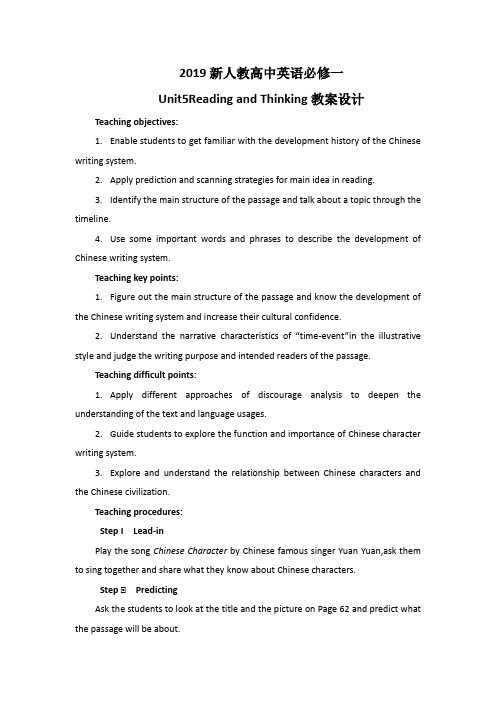
2019新人教高中英语必修一Unit5Reading and Thinking教案设计Teaching objectives:1.Enable students to get familiar with the development history of the Chinese writing system.2.Apply prediction and scanning strategies for main idea in reading.3.Identify the main structure of the passage and talk about a topic through the timeline.e some important words and phrases to describe the development of Chinese writing system.Teaching key points:1.Figure out the main structure of the passage and know the development of the Chinese writing system and increase their cultural confidence.2.Understand the narrative characteristics of “time-event”in the illustrative style and judge the writing purpose and intended readers of the passage.Teaching difficult points:1.Apply different approaches of discourage analysis to deepen the understanding of the text and language usages.2.Guide students to explore the function and importance of Chinese character writing system.3.Explore and understand the relationship between Chinese characters and the Chinese civilization.Teaching procedures:Step I Lead-inPlay the song Chinese Character by Chinese famous singer Yuan Yuan,ask them to sing together and share what they know about Chinese characters.Step Ⅱ PredictingAsk the students to look at the title and the picture on Page 62 and predict what the passage will be about.Suggested answer:The title is“The Chinese Writing System”, which is the topic,and connecting the past and the present is the focus, so the passage is about the development of Chinese writing system.Step Ⅱ Skimming for main ideasRead the passage quickly and find the topic sentence for each paragraph.The main idea of each paragraphSuggested answers:Paragraph 1:The Chinese writing system is one of the main factors why Chinese civilization has survived into modern times.Paragraph 2: Written Chinese was a picture-based language at the beginning.Paragraph 3: The writing system became well-developed and later developed into different forms.Paragraph 4: The writing system began to develop in one direction.Paragraph 5:Written Chinese connects China's present with its past,and has become an art form.Paragraph 6:The Chinese language is helping to spread China’s culture and history to the world.Step IV Scanning for detailsAsk the students to find the words and phrases that describe a time and whathappened to the characters at each of those important times.Activity 1 Read the passage and find out the words showing the timeline,and then finish the timeline.Question: What kind of words can show the development of the Chinese writing system?Draw a timeline to show the narrative order.Suggested answer:modern times(Para.1)→at the beginning(Para.2)→dates back several thousand years(Para.2)→by the Shang Dynasty(around 1600—1046 BCE)(Para. 3)→over the years(Para.3)→the Qin Dynasty(221--207 BCE)(Para. 3,4)→even today (Para.4)→in modern times(Para.5)→today(Para.6)Activity 2 What happened to the Chinese characters at each of those important times?Fill in the table.Suggested answers:1.The Chinese civilization still continues.2.Written Chinese was a picture-based language.3.Longgu appeared.4.Symbols carved on longgu had become a well-developed writing system.5.The writing system developed into different forms, as the Chinese people were divided geographically, leading to many varieties of dialects and characters.6.The Chinese writing system began to develop in one unified direction.7.Chinese people can all still communicate in writing.8.Chinese people can read the classic works which were written by Chinese in ancient times.9.The Chinese writing system is still an important part of Chinese culture.StepⅡReading for languages featuresRead the passage again and find the sentences where the restrictive relative clauses are used.Suggested answers:1. There are many reasons why this has been possible...(Restrictive attributive clause)2.....animal bones and shells on which symbols were carved by ancient Chinese people.(Restrictive attributive clause)3.... it was a time when people were divided geographically.(Restrictive attributive clause)4.Emperor Qinshihuang united the seven major states into one unified country where the Chinese writing system began to develop in one direction.(Restrictive attributive clause)Step Ⅱ DiscussionEncourage students to work in groups,think independently first and then discuss with their partners.1. How did written Chinese unify Chinese people divided by geography and dialects?2.How does written Chinese connect Chinese people today with those of the past?3. According to the writer,the Chinese writing system is one factor that has helped the Chinese language and culture survive. What do you think are some of the other factors ?Suggested answers:1.It allowed Chinese people,no matter where Chinese people live or what dialect they speak to communicate with each other.2.People in modern times can read the classic works in ancient times.3.Except for the writing system of Chinese language, the continuous development of China's agriculture, a relatively powerful government,distinguished philosophical schools,and an open mind to embrace different cultures are all possible and important factors. Besides, education is always emphasized in China's family traditions.Step Ⅲ Vocabulary about the development of Chinese writing system.Activity 1Read the words below and learn them by heart.Activity 2 Use the words and phrases above to introduce the development of the Chinese writing system according to “time & event”.Suggested answer:Several thousand years ago,Chinese characters began as picture-based symbols carved on longgu. By the Shang Dynasty,the symbols had become a well-developed system. Over the years,the system developed into different forms. This, however, changed in the Qin Dynasty when the Chinese writing system began to develop in one direction because Emperor Qinshihuang united seven major states. Even today,not only can Chinese people communicate well by means of it but also many foreign friends come to China to appreciate China's culture and history through this amazing language.Step Ⅲ Homework1.Introduce the development of the Chinese writing system according to “time & event”.2.Try to describe your growth through a timeline.。
人教必修一Unit5_Reading_for_Writing_名师教学设计
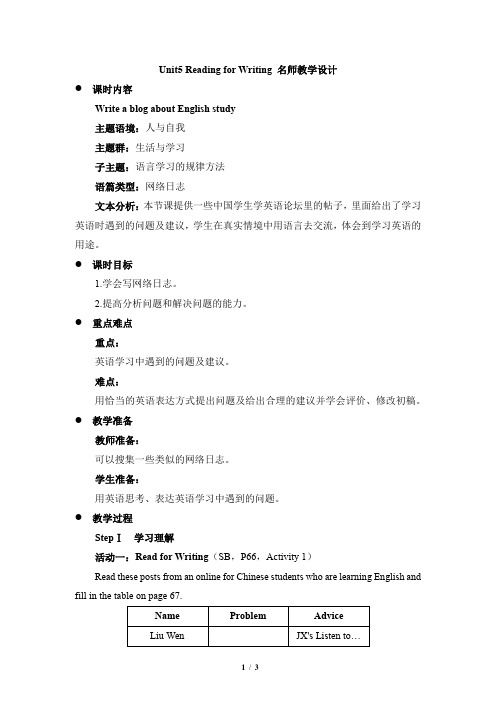
Unit5 Reading for Writing 名师教学设计●课时内容Write a blog about English study主题语境:人与自我主题群:生活与学习子主题:语言学习的规律方法语篇类型:网络日志文本分析:本节课提供一些中国学生学英语论坛里的帖子,里面给出了学习英语时遇到的问题及建议,学生在真实情境中用语言去交流,体会到学习英语的用途。
●课时目标1.学会写网络日志。
2.提高分析问题和解决问题的能力。
●重点难点重点:英语学习中遇到的问题及建议。
难点:用恰当的英语表达方式提出问题及给出合理的建议并学会评价、修改初稿。
●教学准备教师准备:可以搜集一些类似的网络日志。
学生准备:用英语思考、表达英语学习中遇到的问题。
●教学过程StepⅠ学习理解活动一:Read for Writing(SB,P66,Activity 1)Read these posts from an online for Chinese students who are learning English and fill in the table on page 67.【设计意图】在Read for Writing环节中,设计了一个活动,让学生上网查找一些中国学生学英语论坛里的帖子,从中获取ideas,本次写作的主要内容就是根据相应的问题提出建议。
Step Ⅱ应用实践活动二:Work in groups. List your problems in learning English and brainstorm some useful advice.(SB P67,Activity2)语言支架:I don't know how to…I have no idea how/what……is a big difficulty for me.My biggest problem is…I Cannot.I (also) have trouble with…You might try…It's very important to…This worked for me…Problem:e.g. I cannot understand the teacher's English in class. …Advice:…【设计意图】通过搭建语言支架,学生能用正确的句式将自己的想法表达出来,其中有表达问题的句式,也有给出建议的句式。
高一英语必修一UNIT5教案

篇一:高一英语必修一unit5教学设计教材分析我教的是高一年级上册,人教版,必修1, unit5, nelson mandela---a modern hero 的第一课,这是一节高中阅读课。
教材上这一部分主要分为四个部分:由于第一、二部分联系比较紧密,活动设置也比较好,但我觉得这两部分的活动顺序可以调整一下,即把第二部分放在前面,先呈现图片和简介以引起学生注意力和兴趣,以图片展示的形式激励学生用英语进行语言实践活动,然后归纳出hero的一个模糊标准,为阅读活动做好铺垫。
然后再让他们自己说出他们所认为的a great person 所拥有的品质,这样可能更符合学生的思维习惯特点,并且有利于调动他们的积极性和培养他们说语言的能力。
因此,我决定吧第一、二部分结合在一起作为pre-reading 部分来讲,但顺序做一下调整,之后是正式人物曼德拉的登场,进入主题alias眼中的曼德拉,重点把nelson mandela 挑出来,附加更多关于他的信息,稍加重点地呈现,因为他的信息与接下来的reading passage 联系非常紧密,我想通过重点呈现关于他的信息来提高给学生更多background information,帮助他们更好地理解reading text.第三部分是一个关于elias’ story 的reading text,属于人物传记式的阅读,但是文章的写作角度比较特别,由穷苦的黑人工人alias叙述他眼中的曼德拉,这样的写法比较客观可信。
alias的故事与遭遇同时也成为本文与本课的一条贯穿总线,也是这堂课的中心阅读任务。
学生要做的主要活动就是阅读并理解文章的内容和大意,同时注意一些重点细节信息的把握。
另外,在时间允许的情况下,我还想做一些扩展性的教学活动,比如让学生复述alias 的经历,即达到检测学生的理解又能挑战学生说英语的能力。
the background of students:(1) the supporting background information should be given to students before reading to get them ready and not feel difficult.(2) the teaching procedures and reading task should be designed adaptive to students’ current ability and their cognitive style.(3) teacher should give students necessary guidance on reading strategies(4) teacher should be amiable and patient to make students less nervous.correctly to encourage them and improve their confidence.teaching plan for s1 a reading lesson (lesson 1, unit 5, 必修1)nelson mandela---a modern heroname: 颜巧云 class: english 07(4) group: 4-1teaching/learning objectives4. develop reading skills: skimming, scanning and generalizing the central meaning of the textteaching procedures:stage1. pre-reading (5-10 minutes)do you think he is a great man?step2. guess game for prediction (present pictures of 6 famous persons both in nelson mandela.step2. check ss’ understanding of the main idea of each paragraph through matching.step2. guide ss to finish t/f exercises and give their reasons to check ss’understanding of specific information.information and train their independent thinking and judgment, and help to enhance their ability to organize their ideas logically.people equal?e.g. 1940: born1946: six, educated, 2 years1948: leave school, could not pay fee……….stage3. post-reading (10-15 minutes)step2. listen to the tape and read the quotes from nelson mandela to help ss feel the passion and the firm faith of the great man.step3. guide ss to summarize and explore the implied meaning of the text---a great man need not to be famous, he / she must have some good qualities and devote themselves to helping others.(1) ss try to summarize the language points by themselvespart of verbatim plan for lesson1, unit5, s1a, 必修1-----nelson mandela- a modern herot: (after greeting ss)ss: (some ss may give their opinions)t: do you think he is a great man?ss: yes/no.ss: yes/ no.ss: (get into brainstorming)…t: ok, class, have you finished it?ss: yes.篇二:人教版高中英语必修一 unit 5教案unit 5 nelson mandela——a modern hero教材分析:本单元以 nelson mandela —— a modern hero 为话题,目的在于使学生了解一个伟大的人应具备怎样的品质,学会表达自己的观点,并用所学的句型来描写一个伟人。
2019新人教高中英语选择性必修一Unit 5 Reading and Thinking公开课教案
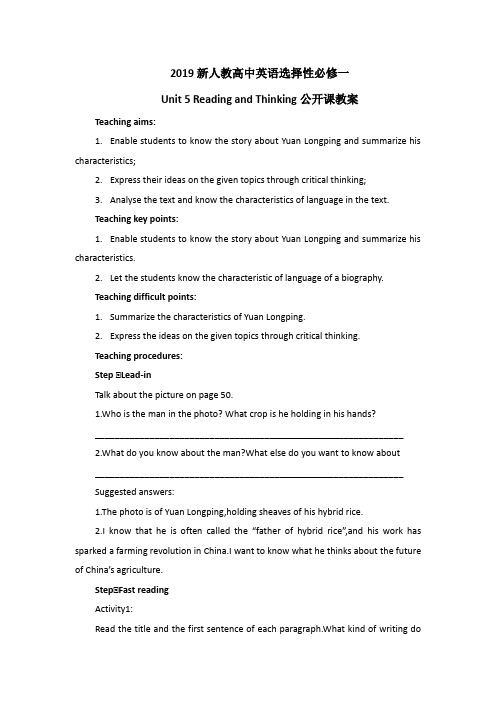
2019新人教高中英语选择性必修一Unit 5 Reading and Thinking公开课教案Teaching aims:1.Enable students to know the story about Yuan Longping and summarize his characteristics;2.Express their ideas on the given topics through critical thinking;3.Analyse the text and know the characteristics of language in the text.Teaching key points:1.Enable students to know the story about Yuan Longping and summarize his characteristics.2.Let the students know the characteristic of language of a biography.Teaching difficult points:1.Summarize the characteristics of Yuan Longping.2.Express the ideas on the given topics through critical thinking.Teaching procedures:Step ⅠLead-inTalk about the picture on page 50.1.Who is the man in the photo? What crop is he holding in his hands?______________________________________________________________2.What do you know about the man?What else do you want to know about______________________________________________________________Suggested answers:1.The photo is of Yuan Longping,holding sheaves of his hybrid rice.2.I know that he is often called the “father of hybrid rice”,and his work has sparked a farming revolution in China.I want to know what he thinks about the future of China’s agriculture.StepⅠFast readingActivity1:Read the title and the first sentence of each paragraph.What kind of writing doyou think this is?Where can you find such a piece of writing?Suggested answers:I think it is a biography.We can always find this kind of writing in a journal.Activity 2Read the text.Match the main idea with each paragraph.Para.1 A.Yuan conducted research and developed hybrid rice.Para.2 B.Yuan is old but still working hard to fulfil his dreams.Para.3 C.Yuan considers himself a farmer.Para.4 D.Yuan decided to study agriculture.Para.5 E.Yuan’s innovation has helped to feed more people.Para.6 F.Yuan cares little for fame or wealth.Suggested answer:CDAEFBStepⅠ Detailed readingRead the text again and answer the questions.1.Why does Yuan Longping consider himself a farmer?_____________________________________________2.Why did Yuan decide to study agriculture?_____________________________________________3.What is the main advantage of hybrid crops?_____________________________________________4.How has Yuan’s work helped China and other countries?_____________________________________________5.What attitude does Yuan hold toward money or fame?What does he do?______________________________________________6.What is Yuan’s latest vision?_______________________________________________Suggested answers:1.Because he continually works the land in his research.2.He considered that farmers had poor harvests and sometimes even had a shortage of food to eat.3.One characteristic of hybrids is that they usually attain a higher yield than conventional crops.4.Yuan’s innovation has helped feed not just China,but many other countries that depend on rice as well,such as India and Vietnam.5.He cares little for celebrity or money. Instead,he makes large donations to support agricultural research.6.Seawater rice.StepⅠ Text type analysis1.Since we have learned something about Lin Qiaozhi and Tu Youyou,do you still remember the main ideas of the two passages?___________________________________________________________2.Can you tell me what should be included when we are introducing a person to others?And what are included in this passage?____________________________________________________________3.In the text,the writing technique of contrast is used for many times.Can you find out them?_____________________________________________________________Suggested answers:1.Lin Qiaozhi overcame a lot of difficulty and sacrificed a lot to become the “mother of ten thousand babies”while Tu Youyou and her team did a lot of research to obtain artemisinin.2.Birth,education,achievements,awards,deeds,evaluation,characteristics and so on. In this passage,education about Yuan, his education, his efforts, his achievements,and his characteristics are all mentioned.3.Para.1 father of hybrid rice vs farmer;Para.2 his parents’ wish vs his own decision;Para.3 the general assumption about hybrid rice vs his belief;Para.5 retire to a life of leisure vs continue to work the land as a man of the soil.Step Ⅰ SummaryAfter reading the passage,what do you think of Yuan Longping? Think about some adjectives to describe him.Suggested answers:1.modest;2.generous;passionate;4.simple/plain;5.creative;6.determine d;7.devoted/committedStepⅠ Critical thinkingFood is the most significant thing in the world,because everyone lives on food.Do you know what kinds of measures can we take to make sure everyone can save food well?Suggested answer:First of all,governments should call on people to save food and avoid wasting food.“Clear the plate” campaign is one of the effective measures.As for us students,we should order what we can eat.If we have ordered too much,we’d better pack and take the left-over st but not the least,when we witness others wasting food,it’s our duty to warn them not to do so.At the same time,we should educate the people around us to build up the idea that wasting is a shame.StepⅠ Language useFill in the blanks to complete the passage.Yuan Longping,born in 1930 in Beijing,chose to study agriculture to tackle food 1. (short).After 2.(graduate) in 1953,he worked as a researcher.Yuan was convinced that the creation of hybrid rice could solve this problem.Through intense effort,Yuan overcame enormous technical difficulties to develop the first hybrid rice in 1974,3.enabled farmers to expand their output greatly.Today,it is estimated that about 60 percent of domestic rice consumption in China 4.(comprise) of crops generated from Yuan’s hybrid strains.Yuan’s innovation has helped feed not just China,but many other countries 5.________ (depend) on rice as well,such as India and Vietnam.Because of his invaluable contributions,Yuan Longping has received numerous awards both in China and abroad.6. a man of the soil,he cares little for celebrity or money.7.,he makes large donations to support agricultural research.8.impresses people most about Yuan Longping is his ongoing ability to fulfil his dreams.His latest visionfor “seawater rice” has also become a reality,and 9.(potential) opened up nearly one million square kilometres of salty land in China for rice production.Despite his advanced years,Yuan Longping is still young at heart and full of vision,and everyone is waiting to see what he will dream up next.10.(know) as the“father of hybrid rice”,Yuan Longping is really one of China’s most famous scientists.Suggested answers:1.shortage2.graduating3.which4.is comprised5.depending6.As7.Instead8.What9.potentially10.KnownStepⅠ Homeworksurf on the Internet to find more about Yuan Longping and take notes.。
高一英语必修一unit5教案

高一英语必修一unit5教案高一英语必修一unit5教案1(一) 教材地位和教学内容分析本课是高一必修模块1第4单元的阅读课型,这单元围绕earthquakes这一主题开展听、说、读、写多种教学活动。
Reading设计为本单元的第2课时。
本课型是单元整体教学的重要环节,为学生的语言学习、语法学习提供了载体,并且是学生获取信息的主要来源。
“Reading―――A NIGHT THE EARTH DIDN’T SLEEP”具体描写1976年唐山大地震的震前、震中和震后。
本篇文章词汇量大,运用了大量的动词、复杂的数字,出现许多定语从句,篇幅较长,并且采用一些修辞手法,对学生的语言阅读能力提出了更高的要求。
但文章的结构较明显,较容易归纳出各部分的中心词。
(二)教学目标1. 语言知识目标:a)使学生了解自然灾害的相关词汇,并掌握复杂数字的表达法。
b)学习掌握与地震相关的词汇,如:shake,well,rise,smelly,pond,pipe,burst,canal,steam,ruin,injure,destro y,brick,dam,useless,steel,shock,quake,rescue,electricity,disaster,arm y,organize,bury,coal,mine,shelter,fresh,percent等,以及right away, at an end, dig out, give out, thousands of以及一些优美句子的赏析。
2. 语言技能目标:a)阅读技能的训练:让学生学会克服生词障碍,通过略读,归纳出文章的大意;通过细读,理清文章的总体框架与脉络,归纳出各部分的中心词;通过查读,捕捉文章的重要细节,培养学生获取、处理信息的能力。
b) 让学生复述课文,分析、感悟作者的写作意图。
c) 让学生运用本节课所学词汇、知识,通过采访唐山大地震幸存者的形式进行小组活动,提高学生用英语进行创造性交流的能力。
高一英语必修一第五单元教案

高一英语必修一第五单元教案高一英语必修一第五单元教案「篇一」一、教学目标知识目标1. Get students to learn some useful new words and expressions in this part。
2. Get students to read the play。
3. Let students learn the expressions of ordering food。
能力目标1. Develop students’ reading skills and enable them to learn how to use different reading strategies to read different reading materials。
2. Enable students to understand and act out the play。
3. Have students learn how to use the expressions to order food。
情感目标1. Stimulate students’ interests of learning English by reading and acting this play。
2. Develop students’ sense of group cooperation and teamwork。
二、教学重点1. Develop students’ reading and speaking skills。
2. Let students read and act the play。
3. Have students learn to use the expressions to order food。
三、教学难点1. Enable students to learn to use reading strategies such as skimming, scanning, and so on。
新人教必修一Unit 5 Languages Around the World教案

Unit 5 Languages Around the World-Listening andSpeaking【教材分析】不同于旧教材,语言差异在必修一的第二单元,新教材设置在必修一最后一个单元,可以让学生在语言上有所储备,就是在前几个单元的学习中,既有语言知识,也有语音知识,到了这个时候学生就能够有话可说,有感可发,能够找到不同国家英语的区别。
让学生学习不同国家和地区的英语,就可以培养学生的国际视野,可以降低学习英语的恐惧感,也可以让学生明确自己的目标。
【教学目标与核心素养】1.语言能力目标新课标重视培养学生语言的使用能力,本单元通过听来带动说,和平时生活紧密相关,让学生可以体会到不同国家使用英语的过程中会有不同的口音,中式英语也肯定具有它的特点,但是作为语言学习者,我们应该尽量模仿英美国家使用语言的地道性,这样可以拓展学生的国际视野,有助于下一步的开展跨文化交流。
2.学习能力目标:在听力当中,学生应该有效规划学习方法,选择恰当的策略与方法。
这节课,教师可以侧重培养在听的过程中让学生记录关键信息,写下关键词的训练,让学生不是为了做题而听听力造成的紧张感,又不能在听的过程中只见树木不见森林。
【教学重点】(1)在听的过程中先听懂,然后快速记录下关键信息,并通过交换信息来获取更多信息;(2)明确自己要听的主要内容集中精力抓住重点。
【教学难点】(1)听力中涉及到数字一直是学生听力的难点,要让他们对于20以内的数字比较熟悉,才能听到之后立马反应过来;Unit 5 Languages Around the World-Reading andThinking【教材分析】本节课是高中英语第一册的最后一个单元的阅读和思考部分,文章难度明显增加,体现在以下几个方面:文章题材是说明文,比较难理解;话题生疏,涉及到历史等知识;生词量增大,而且在语境中理解词汇的要求提高。
面对这些,教师的难度和高度也要有所提升,通过探讨说明顺序,了解背景知识等帮助他们找到说明文阅读的方法。
高一英语必修一Unit5Reading
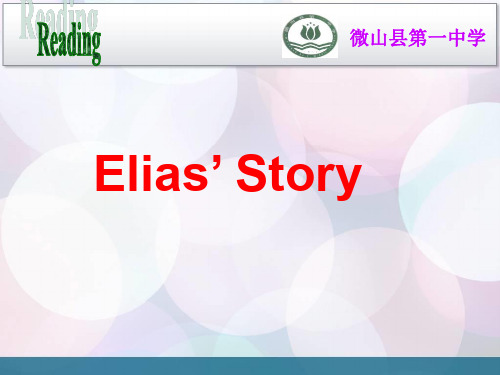
1952:
1963:
left school. Nelson Mandela opened his law firm. Elias helped Nelson Mandela blow up some government buildings.
Task2:Read the text carefully and tell the statement True or False.
3. 共和国; 共和政体 republic principle 4. 法则; 原则
5. 和平的; 平静的 6. 律师 peaceful
n.
adj.
lawyer
n.
7. 费(会费,学费); 酬金 8. 投票; 选举 9. 暴力; 暴行 10. 攻击,进攻 11. 平等 12.不公平的
fee vote violence attack equal unfair
When Elias first met Mandela, he was in a period of his life. After he got a job, he difficult _ out of work because was worried about being _______ he didn’t have a passbook. Then Mandela, who offered guidance ____ to poor black people on their legal problems, told him what to do and helped him. At that time, black people couldn’t _vote or choose their leaders, get the jobs they _______ wanted or lived in the parts of town which were decided by white people. With the help of Mandela they chose to attack the laws, fought against the white people with ___ violence . In 1963 he helped __ blow up some government buildings. It was dangerous for him, but he knew it was to achieve ______ their dream of making black and white people __ equal.
高一英语必修一第五单元教案精选5篇

高一英语必修一第五单元教案精选5篇高一英语必修一第五单元教案【篇1】第一部分:热身快速应答:1.How are you going to school everyday?2.Thank you very much for your help.3.Would mind my opening the window?4.What day was it yesterday?5.What's the weather like today?第二部分:朗读口语朗读技巧:1.声调与降调I have three English books, two Chinese dictionaries and five pens. Do you havea map in your hand? Yes, I do.2.连读:将前一个单词最后的辅音与后一个单词开头的元音连在一起朗读。
half an hour ran out of not at all3.失爆:当相邻两个爆破音在一起时,往往给前面一个爆破音留一个位置,但不爆破,稍停随即发后面的爆破音,这种现象称为“失爆”。
hot bath the next day a good deal of I don’t believe I don’t know I want to say朗读练习:1. A smart housewife was told that there was a kind of stove which would only consume half of the coal she was burning. She was very excited, and said: That'll be terrific! Since one stove can save half of the coal, if I buy two, no coal will be needed!2.The little boy did not like the look of the barking dog.It's all right, said a gentleman, don't be afraid. Don't you know the proverb: Barking dogs don't bite?Ah, yes, answered the little boy. I know the proverb, but does the dog knowthe proverb, too?高一英语必修一第五单元教案【篇2】一、教材分析:本课是结合人教版高中英语教材选修5中有关过去分词的语法内容,进行过去分词的学习,教学中将语法知识的传授和语言基本技能的学习结合到一起,注重复习语法与语言的运用。
【教案】Unit+5Reading+for+writing+教学设计人教版高中英语必修第一册
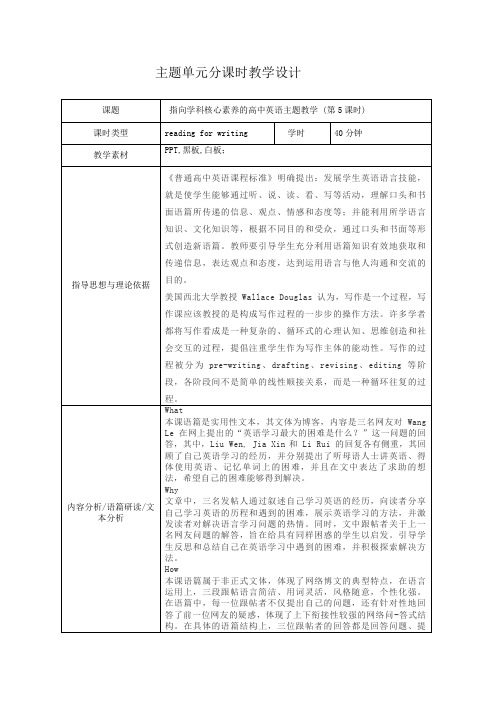
主题单元分课时教学设计课题 指向学科核心素养的高中英语主题教学 (第5课时)课时类型reading for writing学时40分钟教学素材PPT,黑板,白板;指导思想与理论依据《普通高中英语课程标准》明确提出:发展学生英语语言技能,就是使学生能够通过听、说、读、看、写等活动,理解口头和书面语篇所传递的信息、观点、情感和态度等;并能利用所学语言知识、文化知识等,根据不同目的和受众,通过口头和书面等形式创造新语篇。
教师要引导学生充分利用语篇知识有效地获取和传递信息,表达观点和态度,达到运用语言与他人沟通和交流的目的。
美国西北大学教授Wallace Douglas认为,写作是一个过程,写作课应该教授的是构成写作过程的一步步的操作方法。
许多学者都将写作看成是一种复杂的、循环式的心理认知、思维创造和社会交互的过程,提倡注重学生作为写作主体的能动性。
写作的过程被分为pre-writing、drafting、revising、editing等阶段,各阶段间不是简单的线性顺接关系,而是一种循环往复的过程。
内容分析/语篇研读/文本分析What本课语篇是实用性文本,其文体为博客,内容是三名网友对Wang Le在网上提出的“英语学习最大的困难是什么?”这一问题的回答,其中,Liu Wen, Jia Xin和 Li Rui 的回复各有侧重,其回顾了自己英语学习的经历,并分别提出了听母语人士讲英语、得体使用英语、记忆单词上的困难,并且在文中表达了求助的想法,希望自己的困难能够得到解决。
Why文章中,三名发帖人通过叙述自己学习英语的经历,向读者分享自己学习英语的历程和遇到的困难,展示英语学习的方法,并激发读者对解决语言学习问题的热情。
同时,文中跟帖者关于上一名网友问题的解答,旨在给具有同样困惑的学生以启发。
引导学生反思和总结自己在英语学习中遇到的困难,并积极探索解决方法。
How本课语篇属于非正式文体,体现了网络博文的典型特点,在语言运用上,三段跟帖语言简洁、用词灵活,风格随意,个性化强。
人教版选择性必修一Unit 5 Reading and Thinking 教案

Unit 5 A Pioneer for All People---reading and thinking教学设计文本分析主题语境:人与自然(粮食危机的与农业生产)语篇类型:记叙文(人物介绍类)【what】作者较客观介绍了我国著名农业科学家袁隆平的伟大而平凡的一生。
文章人他对于自我身份认识开始讲起,他认为自己是一个道地的农民。
他在大学毅然决然地选择了农业作为自己的专业。
在大学学习期间,尽管遇到了许多困难,他仍然坚持发展杂交水稻,做了许多研究,终于成功地种植出了杂交水稻。
他在事业上的成功为他带来了巨额财富,但是他没有沉迷于这小小的成功,他把钱捐给了国家农业发展,自己也投身到了超级杂交水稻的研究中。
他一生致力于让中国人不挨饿,让世界人民不会因为饥饿死亡,他做到了。
【why】文章通过走进袁隆平,认识并了解他的事业和理想的发展过程,一是让学生们学习他的奉献精神,科学苦干精神,个人前途与祖国利益相结合的时代选择;二是了解中国科学家在解决世界粮食问题中做出了艰苦的尝试并且取得了巨大的贡献和成就。
希望能使学生能有所感悟,并结合自身的真实情况和当今中国的需要,以及当代世界格局进行有益的思考和探所。
【How】篇章结构:这篇文章以时间为线,从袁隆平的出身讲起,依次介绍了他的教育,研究,成就,美德以及他的理想和愿景,从而在 who, what(how),why 三个方面证明了袁隆平是当之无愧的人类的先锋楷模。
文本语言:本文使用第三人称,采用过去时描述袁生平,用现在时展现他的品质,尽量客观地展示了袁隆平人生的各个方面。
其中作者也使用了客观地Activity 4 (7mins)Summarize the text.1.How is the article developed?2.What are the values behind the storyof Yuan?。
必修一英语unit5reading教案
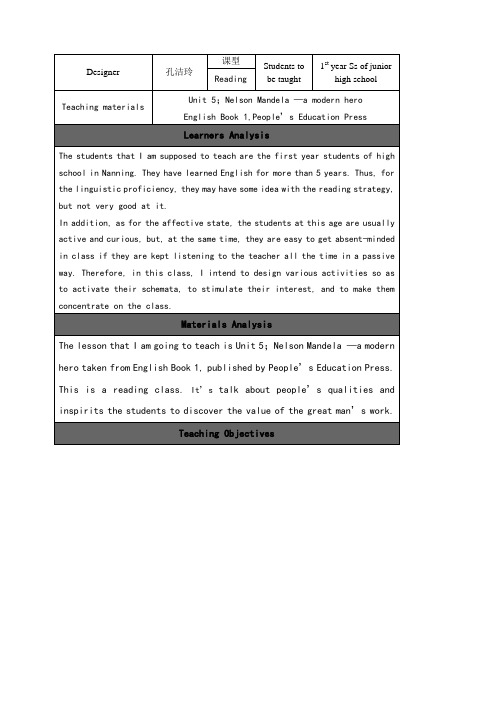
Step2 Retelling
Step 3 Homework
Discuss with Ask the It would 9mins
their
students help
partners and to discuss students
try to retell and retell understan
the story.
they are discussing.
Teaching Methodology
My teaching philosophy: In today’s language teaching classroom, teachers should take the
role of scaffolding for the students. He should not tell the students everything, but provide support for the students to find things on their own. Another key element in language teaching is interaction, without which language cannot be learned. Therefore, the class time should be given to the students’ interactive activities.
then find how general
many parts can ideas and
the text be locating the
divided into specific
Give
the information
人教版英语必修一Unit5Reading:Elias’Story教学设计方案

人教版英语必修一Unit5Reading:Elias’Story教学设计方案人教版英语必修一Unit5 Reading: Elias’ Story教学设计方案一、教学目标1. 通过阅读文章,了解并描述Elias的生活故事;2. 学习并掌握相关词汇和短语;3. 培养学生的阅读理解能力,提高学生的英语口语表达能力。
二、教学准备1. 教材:人教版英语必修一Unit5;2. 多媒体设备;3. 单词卡片和图片。
三、教学过程Step 1: 导入1. Greetings and warm-up:Teacher greets the students and asks some warm-up questions related to the topic of the unit, such as "Do you like reading stories? Why or why not?"Step 2: 预习讲解1. Pre-reading discussion:Teacher asks students to discuss the questions in groups: "What do you know about Ethiopia? Have you heard about children who have to work to survive?"2. Vocabulary introduction:Teacher presents and explains some key vocabulary related to the passage, using realia, pictures, and examples.Step 3: 阅读理解1. Skimming and scanning:Teacher guides students to skim the passage to get a general idea about Elias' story, and then scan specific paragraphs to find answers to given questions.2. Group discussion:Students work in groups to discuss and answer comprehension questions related to the passage.3. Class discussion:Teacher leads a whole-class discussion, and students share their answers and thoughts about Elias' story.Step 4: 语言点拓展1. Language focus:Teacher focuses on language points in the passage, such as grammar, sentence structure, and vocabulary usage. Examples and exercises are used to practice and reinforce the language points.2. Language practice:Students work individually or in pairs to complete language exercises related to the passage, using the target language points.Step 5: 拓展活动1. Extension activities:Teacher provides extra reading materials, videos, or interviews related to child labor and poverty issues for students to explore and discuss further.2. Role play:Students are divided into groups and assigned different roles to act out a dialogue or scene related to Elias' story, showcasing their understanding and empathy toward the topic.Step 6: 总结和评价1. Summary:Students summarize what they have learned from the passage and the activities.2. Evaluation:Teacher assesses students' performance in terms of their participation, comprehension, and language skills.Step 7: 作业布置1. Homework assignment:Students are assigned tasks such as writing a reflection on Elias' story, researching and presenting on child labor issues in different countries, or preparing a skit based on the passage.2. Review:Teacher reminds students to review the vocabulary, grammar, and reading strategies covered in this class.四、教学反思通过本节课的教学设计,学生在阅读、讨论、语言点拓展和互动活动中,可以全面理解并描述Elias的生活故事。
人教版高中英语必修一 unit5教案

教案纸如:You needn’t have bought such an expensive watch for her.你本不必给她买这么贵的手表。
need作为情态动词一般用于疑问句和否定句中。
【活学活用】(1)—You before you opened the door.—I beg your pardon. I didn't know that anyone was in here.“你推门进来之前本该先敲门的。
”“对不起,我不知道这里面有人。
”(2)I the meeting on time—unless I had caught an earlier train.我不可能准时赶到会场——除非我赶上了较早的一班火车。
(3)If he had taken the doctor's advice, he ____________________ (recover) from his illness already. 如果他听从了医生的建议的话,他的病可能已经好了。
(4)They ________have stayed up late last night—all of them look sleepy.他们昨天晚上肯定熬得很晚了,他们看起来全都非常困倦。
(5)We ____________________ so much food now that Suzie won't be with us for dinner.既然苏西不和我们一起吃晚饭,我们本没必要买如此多的食物。
should have knocked couldn't have got to might have recovered must needn't have bought7. We read books under our blankets and used anything we could find to make candles to see the words.我们躲在毯子下面读书,用可以找到的任何东西做蜡烛来看书。
Unit 5 Reading and thinking 教学设计-高中英语必修第一册

Reading and Thinking 教学设计基本信息科目英语年级册次高一必修一版本单元人教版Unit 5姓名学校教学内容分析【What】本节课的话题是阅读了解汉字的发展过程Reading about the development of Chinese characters。
该话题属于主题语境--人与自我--生活与学习。
子话题为语言学习的规律、方法等。
本文是一篇说明文。
标题为The Chinese Writing System,副标题为“Connecting the Past and the Present”。
非文字信息(图片)包括汉字表意特征、汉字“马”由甲骨文到秦统一文字的演进图。
作者通过介绍汉字特点、汉字由起源到秦朝统一汉字的发展过程、以及对比分析古今汉字的使用现象,来阐释说明汉字在古今中华文化传承中所起到的重要作用。
文章共有三个部分,六个段落。
段落内容如下:第一部分(第一段):提出汉字是中华文化传承至今的重要原因。
第二部分(第二段至第四段):介绍了汉字的起源和秦朝汉字统一的意义。
第三部分(第五段至第六段):当代汉字使用的美学价值和文化传播意义。
【Why】本篇文章话题贴合文化交流实际需要,内容简明扼要、叙述逻辑清晰,能够极大的引发学生的阅读兴趣和探究愿望。
文章可以帮助学生理解汉字在中华文化传承中所起到的重要作用,形成文化认同、从而进一步推进中国汉字文化的传播和传承。
学生通过探究汉字的古今发展,可以提高语言运用能力和思维能力。
【How】从内容上,文章贯穿了两条线索。
文章的明线是汉字书写体系的历史发展。
暗线是汉字书写系统对中国文化的贡献。
包括三个维度的探讨:汉字在不同地域的发展与传播;汉字在不同时空的发展与传播;汉字在文化与艺术领域的发展与传播。
为了达到写作目的,作者采用了以下词汇语法手段:(1)文章为了记述汉字的历史发展过程,段落中间以时间连接词贯穿全文:at the beginning, by the Shang Dynasty, over the years, today等等。
- 1、下载文档前请自行甄别文档内容的完整性,平台不提供额外的编辑、内容补充、找答案等附加服务。
- 2、"仅部分预览"的文档,不可在线预览部分如存在完整性等问题,可反馈申请退款(可完整预览的文档不适用该条件!)。
- 3、如文档侵犯您的权益,请联系客服反馈,我们会尽快为您处理(人工客服工作时间:9:00-18:30)。
By the end of this class, the students will be able tothe students to describe a great person with the order of time.
Strategicobjectives
By the end of this class,thestudentswill be able toimprove theirreadingskills.
6min
Step2
Scanning
Finishthe exercise.
Read the passage on page 34 to get the answers to Part 1 and Part 2ofComprehending.
10min
Stage 3:
Post-reading
Step 1
Teaching Methodology
My teaching philosophy:
In today’s language teaching classroom, teachersshould take the role ofscaffoldingfor the students.He should not tell the students everything, but provide support for the students to find things ontheir own.Another key element in language teaching is interaction, without which language cannot be learned.Therefore, the class time should be given to the students’interactive activities.
Students’reading ability of getting the general ideas and locating the specific information can be trained and improved by skimming and scanning practice.
Designer
孔洁玲
课型
Studentsto be taught
1styearSsof junior high school
Reading
Teaching materials
Unit 5;Nelson Mandela—a modern hero
English Book 1,People’s Education Press
Materials Analysis
The lesson that I am going to teach is Unit 5;Nelson Mandela—a modern hero taken from English Book 1, published by People’sEducation Press. This is a reading class.It’stalk about people’s qualities and inspiritsthe students to discover the value of the great man’s work.
To letthe students work collaboratively forunderstandingthe key vocabularyand key structureandgeneral idea of the text(Key point)
Group working for the main structure of introducing their parents and their jobs. Peer correcting is benefit for students to grasp the ability to find out the mistakes and correct them by themselves.
Creat a moving atmosphere
5min
Stage2:
While-reading
Step1:
Skimming
Listen to the tape and get the general idea.
first let’s listen to the tape. While listening, pay more attention to the correct pronunciationthenfind how many parts can the text be divided into? Give the general idea of each part
In addition, as for the affective state, the students at this age are usually active and curious, but, at the same time, they are easy to get absent-minded in class if they are kept listening to the teacher all the time in a passive way. Therefore, in this class, I intend to design various activities so as to activate their schemata, to stimulate their interest, and to make them concentrate on the class.
Follow the teacher and take some notes.
Show some pictures to learn some key words.
Learn linguistic ability.
10mins
Step2
Retelling
Discuss with their partners and try to retell the story.
Learners Analysis
The students that I am supposed to teach are the first year students of high school in Nanning. They have learned English for more than 5 years. Thus, for the linguistic proficiency, they may have some idea with the reading strategy, but not very good at it.
With the teacher’s careful scaffolding and the students’meaningful interactions, the language class will be successful in developing the learners’communicative competence in the end.
Teaching Flowchart
Teaching Procedures
Stages
Steps
Students’activities
Teacher’sactivities
Purposes
Time
Lead-in
Listen the song andanswerquestions.
Get Ssenjoina song<hero>,after that,ask them some questions.
Teaching Objectives
Linguistic objectives
By the end of this class, thestudentswill be able tograsp the vocabulary (period, advise...on, continue, fee, fare, gold/golden, be worried about, out of work, stage, vote, position, accept, violence, as a matter of fact, blow up, put in prison, equal….) and understand some important sentances.
Specific teaching methods:
1) Bottom-up model
2) Inductive method in grammar teaching
3) Communicative approach in speaking activities
Teaching Aids
A recorder, a projector and some slides.
The characteristic of the writing in this unit..(Difficult point)
Give the studentstime to work out the structure and explain the key words for them while they are discussing.
Ask the students todiscuss and retell tቤተ መጻሕፍቲ ባይዱe story follow the time sequence.
It would help students understand this article better
